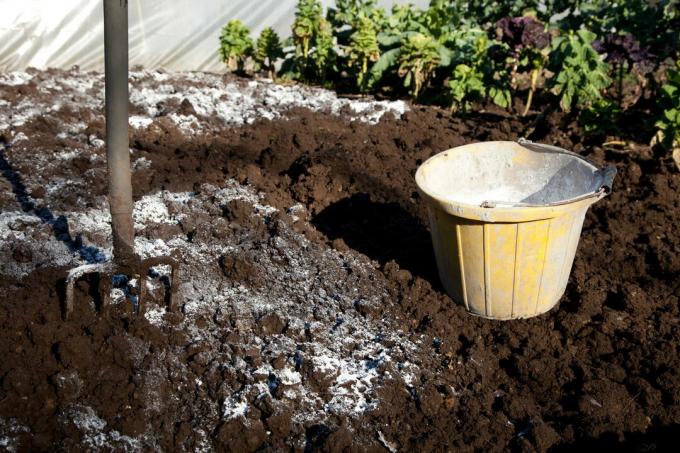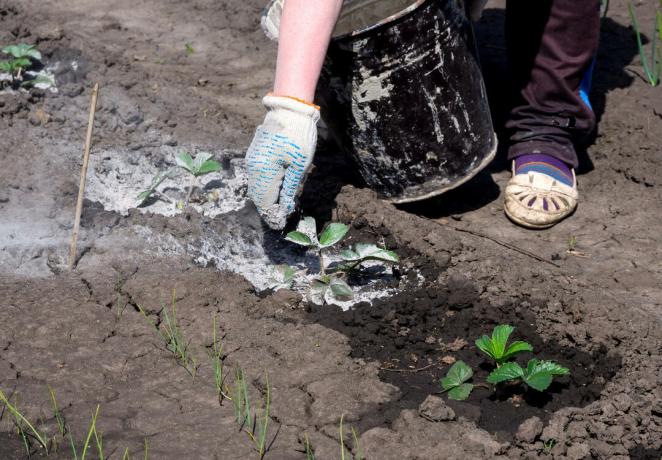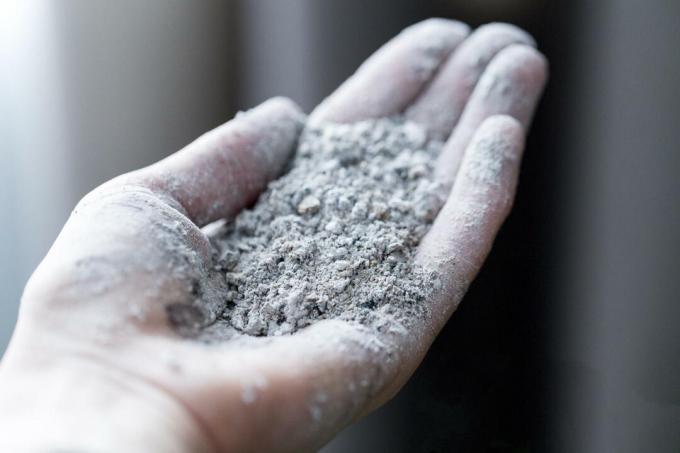One hears again and again that wood ash can be used as fertilizer in the garden. We'll show you what to watch out for when fertilizing with ash.

Wood ash contains many nutrients, but unfortunately it is far too often not used for fertilization. That's a shame, after all, the recycling of nutrients is an important component of sustainable agriculture and gardening. To enable you to use it, we have compiled all the information you need to know about the use of wood ash as a fertilizer.
contents
- Can ash be used as fertilizer?
- How does ash work as a fertilizer?
- Which plants can be fertilized with ashes?
-
Use of ash as a fertilizer
- How much ash to use as fertilizer?
Many stove and fireplace owners are unsure whether ash can be used as fertilizer at all. We answer this question and then explain the effect, the correct application and explain which plants can benefit from fertilizing with ash.
Can ash be used as fertilizer?
Not every type of ash can be safely distributed in the house or garden. Plant ashes are generally suitable to be used as fertilizer - this means ashes from burned wood, straw or other plant material. Normally printed, non-glossy paper is also suitable, so that the ashes from your own fireplace can be used - provided that only untreated wood has been burned. Ashes from briquettes, charcoal, treated wood and glossy printed paper must not be used. Because these materials contain substances that should not get into your garden soil.

How does ash work as a fertilizer?
Ash has a pH value of 10 to 13, it contains a lot of alkaline calcium and magnesium.
| Contained nutrient | Content in untreated wood ash |
|---|---|
| Calcium oxide (CaO) | 26 – 40 % |
| Phosphorus oxide (P2O5) | 4 – 7 % |
| Potassium oxide (K2O) | 7 – 12 % |
| Magnesium oxide (MgO) | 3 – 5 % |
| More trace elements | In variable proportions |
| Nitrogen (N) | Not included |
The nutrients contained in plant ash are readily available: Were they from before the incineration surrounded by an organic packaging made of carbon, this is oxidized during combustion and as a CO2 escaped. The calcium oxide it contains is also known as quicklime. When burned, this form of calcium is also easily soluble and acts quickly. It is therefore also suitable for liming heavy, clay-rich soils. Quicklime reacts with water in the soil, whereby the pH value of the soil solution rises and calcium is released. It is now ready for uptake by plant roots. Incidentally, if the humus content is sufficiently high, calcium acts as a kind of electrical bridge between humus molecules and clay minerals and thus enables the formation of stable soil crumbs. And these are a real blessing for many soil properties, one speaks of the so-called lime fermentation. It should be noted that ash does not bring in organic material or nitrogen. It can be viewed as a nitrogen-free mineral fertilizer with a very high pH.
Tip: Because light, sandy soils can easily be covered with quicklime, it is better to use carbonate of lime - for example from eggshells - on them.
Summary: How does ash work as a fertilizer?
- Ash is very basic and can raise the soil pH very quickly
- The plant nutrients it contains are readily available - but it does not contain nitrogen
- Light soils are easily covered with limescale, so the pH value is raised too quickly and too much. Ash can be used on heavy, clayey soils
- The released calcium promotes the formation of stable soil crumbs (lime fermentation)

Which plants can be fertilized with ashes?
The alkaline effect of ash should by no means be underestimated: precisely because quicklime is so easily soluble, there is a not inconsiderable risk of over-lime formation. A massive increase in the pH value due to an overly generous distribution of ash can upset the soil chemistry in such a way that the plants growing there can no longer absorb nutrients, at least for a short period of time, their growth is inhibited or even enter. This is especially true for the plants that are actually used to acidic soils: Rhododendrons (rhododendron), blueberries (Vacciniummyrtillus), Sham berries (Gaultheria), Ferns and many forest shrubs, for example. Lime-loving plants and those with a high calcium requirement tolerate ash better and can even benefit from it. In the following table we have compiled a selection of lime-loving plants. You can find a further selection of lime-loving plants in our special article on Fertilizing with egg shells.
| Lime-loving perennials | Lime-loving trees |
|---|---|
| Garden silver arum (Dryas x suendermannii) | Different types of maple (Acer campestre, Acer negundo, Acer platanoides, Acer pseudoplatanus i.a.) |
| Garden thistle (Echinops ritro subsp. ritro) | Hornbeam (Carpinus betulus) |
| Rolled Wolf Milk and Colorful Wolf Milk (Euphorbia myrsinites / Euphorbia polychroma) | Deutzien (Deutzia in their types and varieties) |
| Wild strawberry (Fragaria vesca var. Vesca) | Ivy (Hedera in their types and varieties) |
| Woodruff (Gallium odoratum) | Mother-of-pearl (Kolkwitzia amabylis) |
| Crimson cranesbill (Geranium sanguineum) | Philadelphus / False Jasmine (Philadelphus in its types and varieties) |
| Rispige gypsophila (Gypsophila paniculata) | Woolly, Ordinary, Japan and Tongue Snowball (Viburnum lantana, Viburnum opulus, Viburnum plicatum, Viburnum rhytidophyllum) |
Use of ash as a fertilizer
Because of the strongly alkaline effect of ash, a pH test of the soil should always be carried out before use. If your garden soil is only slightly acidic, neutral or even slightly alkaline, ash should only be used cautiously or not at all. If pure ash gets on parts of plants, this corrodes the plant tissue. Because plant ashes do not contain any nitrogen or organic material, supplementary fertilization should definitely be used to supply the plants. Organic long-term fertilizers are ideally suited, including ours Plantura organic fertilizer - again Plantura organic universal fertilizer - counting.
Basically:
- Spread out ashes when there is no wind: This prevents lime-sensitive plants from being damaged in other parts of the garden
- Wear gloves when spreading ashes as the high pH will damage your skin
- Moistening the ashes reduces the formation of dust
- Water the soil after application
- Never apply ash in connection with fertilizers containing ammonium such as liquid manure, manure or mineral nitrogen fertilizers - this would result in gaseous ammonia
- Never apply ash in connection with mineral phosphates or fertilizers containing phosphates - calcium phosphates would be formed, which are difficult to dissolve and are no longer available to the plants
Remember that most garden soils have no need for lime or calcium, as calcium-containing minerals are found in almost all locations. The use of ash or lime is usually only necessary for plantings with plants that are explicitly lime-loving or for potting soil based on peat. Peat soil brought into pots and beds is often severely depleted in calcium after a few years, since peat naturally has almost no calcium.

How much ash to use as fertilizer?
On heavy, acidic soils (pH value 4), 200 to 400 grams of plant ash per square meter can be applied every three to four years. Less acidic soils can be treated with 100 to 200 grams of plant ash every three to four years. You should not spread ash on light soils, as this can quickly lead to over-limescale. Better to use ground ones Egg shells as fertilizer, the effects of which we will present to you in more detail in this special article.
Tip: Another application for ash is in the domestic compost heap. Since microorganisms become more active at high pH values, composting can be accelerated by adding ash. However, more volume of the compost is lost than composting would take place without lime. If possible, only use ash if you want to compost acidic compost material: Oak leaves, coniferous wood chips or peat soil can be powdered with a thin layer of ash.

Summary: using ash as a fertilizer
- The use of ash is only useful for plants that love lime, peat soils or soils that are proven to be too acidic or low in calcium. The latter is very rare
- Ash should not get onto plant tissue in its pure form, as it can cause chemical burns
- As ash does not contain nitrogen, additional fertilization with an organic long-term fertilizer is necessary
- Ash can also be spread over acidic rotting material on the compost in order to balance its pH value
If you want to know more about the Use of natural fertilizers you can find more reading material in our overview article.
As ash alone is not enough to cover the complete nutritional needs of the plant, we recommend adding an organic long-term fertilizer. Thanks to their primarily organic raw materials, ours complement them Plantura organic fertilizer the natural fertilization with ash optimal and ensure a long-term supply of nutrients.



